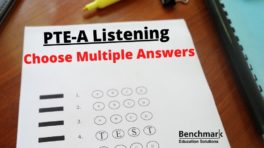Understanding Accents in the PTE Listening Section
- 0 Comments


One of the biggest challenges in the PTE Listening section is understanding different English accents. PTE audio recordings feature speakers with British, Australian, North American, and occasionally Indian accents, which can be difficult for non-native English speakers.
Many test-takers struggle with:
- Unfamiliar pronunciations of words they already know.
- Different speech rhythms and intonations in various accents.
- Fast-paced speech that makes it difficult to keep up.
- Regional vocabulary and slang that might not be common in standard English learning materials.
Why Does PTE Include Different English Accents?
PTE is a global English proficiency test, widely accepted in Australia, the UK, Canada, and the USA. To ensure candidates can handle real-world English communication, the listening section features accents from these regions
The accents most commonly heard in PTE Listening include:
- British (UK) English – Formal tone, crisp pronunciation, and distinct vowel sounds.
- Australian English – Faster speech, informal tone, and slightly slurred pronunciation.
- North American (US/Canada) English – Clear enunciation, rhotic ‘r’ sounds, and direct intonation.
- Indian English (Occasionally) – Slightly different stress on syllables and word pronunciation.
For a list of essential words and phrases commonly used in PTE audio, check Top 50 Common PTE Listening Keywords and Phrases.
Table of Contents
How to Recognize and Adapt to Different Accents in PTE Listening
1. British English (UK Accent)
Key Characteristics:
- ‘R’ sound is softer or silent (e.g., “car” sounds like “cah”).
- ‘T’ is pronounced clearly (e.g., “butter” sounds like “but-ter” instead of “budder”).
- Vocabulary differences (e.g., “flat” instead of “apartment”).
Example Sentences in British English:
- “The government is implementing a new scheme to reduce emissions.” (scheme = program)
- “She’s going to the university to study law.” (the university = British speakers use “the” before university)
- “Could you get me a jug of water?” (jug instead of pitcher)
How to Practice:
- Listen to BBC News, TED Talks from British speakers, and UK-based podcasts.
- Watch British shows like BBC documentaries or UK talk shows.
- Familiarize yourself with British idioms and formal expressions.
Pro Tip: Focus on vowel pronunciation—British English often has longer vowel sounds compared to American English.
For help recognizing transitional phrases in different accents, check How to Recognize and Use Signpost Words in PTE Listening.
2. Australian English (Aussie Accent)
Key Characteristics:
- Fast speech with words often “blended” together.
- Informal and shortened words (e.g., “afternoon” becomes “arvo”).
- Different vowel sounds (e.g., “mate” sounds more like “mite”).
Example Sentences in Australian English:
- “G’day mate! Fancy a barbie this weekend?” (barbie = barbecue)
- “It’s a scorcher today, better put on some sunnies.” (scorcher = very hot day, sunnies = sunglasses)
- “Let’s meet up at Macca’s for brekkie.” (Macca’s = McDonald’s, brekkie = breakfast)
How to Practice:
- Listen to ABC News Australia, Australian sports commentary, and YouTube travel vlogs from Australian content creators.
- Watch Australian TV shows like MasterChef Australia or The Project.
- Practice listening to Australian podcasts such as The Aussie English Podcast.
Pro Tip: Australians tend to drop the ‘r’ sound at the end of words and use rising intonation at the end of sentences.
For strategies to avoid getting confused by fast-paced speech, check How to Tackle Tricky Audio in the PTE Listening Section.
3. North American English (US/Canadian Accent)
Key Characteristics:
- Clear enunciation with strong ‘r’ sounds (e.g., “car” sounds like “carr”).
- More relaxed pronunciation (e.g., “butter” sounds like “budder”).
- Common informal expressions and phrasal verbs (e.g., “gonna” instead of “going to”).
Example Sentences in North American English:
- “I gotta grab some coffee before work.” (gotta = got to)
- “Could you fill out this form?” (fill out = complete)
- “He’s been working 24/7 on that project.” (24/7 = all the time)
How to Practice:
- Listen to CNN, NPR, or The New York Times podcasts.
- Watch American movies and TV shows like Friends, The Office, or Breaking Bad.
- Engage with TED Talks from American speakers.
Pro Tip: American English speakers stress content words and often use phrasal verbs.
For ways to stay focused when listening to different speech patterns, check How to Stay Focused During the PTE Listening Section.
4. Indian English (Occasionally in PTE Listening)
Key Characteristics:
- Slightly different stress on syllables compared to British or American English.
- Clearer pronunciation of consonants (e.g., “t” and “d” sounds are stronger).
- Formal and direct style of speaking.
Example Sentences in Indian English:
- “Please do the needful and send the documents at the earliest.” (do the needful = take the necessary action)
- “Kindly revert back with the details.” (revert back = respond)
- “She is staying in a PG near her workplace.” (PG = paying guest accommodation)
How to Practice:
- Listen to Indian news channels like NDTV or The Times of India podcasts.
- Watch interviews of Indian professionals speaking English.
- Practice listening to recordings of Indian speakers presenting business reports.
Pro Tip: Indian speakers tend to use British English spelling and vocabulary but with different pronunciation patterns.
For note-taking techniques that help track key details in all accents, check How to Manage Your Time Effectively in the PTE Listening Section.
Final Tips for Understanding Accents in PTE Listening
- Practice listening to different accents regularly to train your ears.
- Don’t focus on every word—listen for meaning and key points.
- Pay attention to signpost words that indicate main ideas or transitions.
- Take advantage of free online listening resources to improve comprehension.
For full listening test simulations, check Listening Mock Test PTE.
Conclusion
The PTE Listening section can be challenging due to the variety of English accents used in recordings. However, by practicing regularly with diverse listening materials, focusing on key pronunciation differences, and using active listening strategies, you can improve comprehension and boost your PTE score.
At Benchmark PTE, we provide expert strategies, structured mock tests, and targeted practice exercises to help you adapt to different English accents and confidently tackle the PTE Listening section. With consistent exposure and smart learning techniques, you’ll develop stronger listening skills and improve your performance in PTE Listening.











